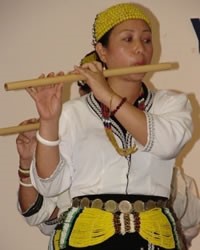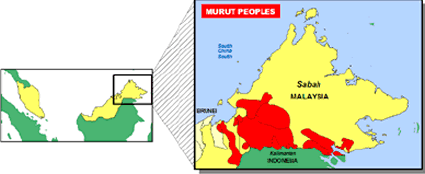The Lun Bawang (A.K.A, Murut) comprise several people groups that are scattered in parts of Borneo Island including Brunei, Kalimantan (Indonesia), and the East Malaysian states of Sabah and Sarawak. Their largest numbers are in Sabah but some also inhabit the rural Temburong District in Brunei. They were among the last tribal groups on Borneo to renounce headhunting. The largest Lun Bawang people groups are Tagal, Tidung, Timugon, Sembakung, Paluan, Bookan, Kalabakan, and Serundung Murut.
The literal meaning for Murut is 'hill people'. They were formerly shifting cultivators moving their settlements every few years. Each people group has their own dialect, but most are also conversant in Malay which is the national language in Brunei and Malaysia.
The Lun Bawang used to live in communal longhouses, usually near rivers. Today, they have abandoned this style of living for individual family houses. These modern-style villages are still located in the areas of their former longhouse communities. They are a very hospitable people.
Traditionally, they used the rivers as their highways. They planted hill rice and tapioca and hunted and fished for a living. The men were skilled hunters, using blowpipes, spears, and hunting dogs. Today, cultivating hill rice is their principal occupation. Saw milling, timber processing, and military careers are other means of livelihood.
Generally speaking, the Lun Bawang in Brunei have participated in the economic prosperity and modernization of Brunei Darussalam over the past few decades. The Lun Bawang in Sabah have also had increased opportunities resulting from modernization, although those who live in remote locations have not benefited as much from these changes.
Many of the Lun Bawang peoples in both Sabah and Brunei characterize their entire people group as being Christian. However, this is often done to distinguish their culture from their earlier culture and from the predominant Muslim culture than to characterize individual beliefs.
Many of those that call themselves Christian are nominal believers. Among church members, there is a mix of Roman Catholic and Protestant affiliations. Brunei statistics reveal that the Lun Bawang community is 58% Muslim, 30% "tribal religionists" (animists) and the rest Christian. Malaysian census data count the Lun Bawang in Sabah as about 82% Christian, 13% Muslim, and 5% other religions. These numbers can be misleading since they count all those in a household as having the same belief as the head of the household.
Opportunities for better education and economic improvement are limited in the more remote areas. Those choosing to pursue better opportunities are forced to move out of their local culture. Pray that in the face of local restrictions believers will persevere and will also share the good news. His Word is available in some of their languages.
Pray that non-believers, as well as the many nominal believers, would respond to his truth as they hear and read it.
Pray for the Holy Spirit to move powerfully in their families and communities, leading hundreds to a vibrant relationship with Jesus Christ.
Pray that soon Lun Bawang Christians will evangelize and disciple others.
Scripture Prayers for the Lundayeh, Lun Bawang in Brunei.
Southeast Asia Link - SEALINK Copyrighted © Used with permission.
| Profile Source: Joshua Project |











